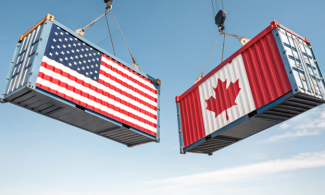
Navigating the Impact of Delayed Canada-US Tariffs: What Businesses Need to Know.
As of February 3, 2025, the proposed tariffs between Canada and the US have been delayed for at least 30 days, following last-minute discussions between Prime Minister Justin Trudeau and US President Donald Trump. While this pause offers temporary relief, Canadian businesses need to stay vigilant as these tariffs could still take effect soon, significantly impacting cross-border trade, operational costs, and supply chains.
In this blog, we'll break down the key developments, potential impacts, and strategies businesses can adopt to navigate these uncertain times.
The Current Landscape: What’s Happening?
The US initially announced a 25% tariff on nearly all Canadian goods, sparing only energy products, which would face a reduced 10% tariff. In response, Canada planned to impose 25% tariffs on $30 billion worth of American goods, with additional tariffs on $125 billion in US goods to follow within 21 days. However, after recent negotiations, both countries have agreed to delay these measures.
The proposed tariffs are part of a broader trade conflict that also involves Mexico, with the US delaying tariffs on Mexican goods for 30 days. While the temporary pause offers businesses a brief window to prepare, the economic ripple effects are already in motion.
How Do Tariffs Work?
A tariff is a tax imposed on imported or exported goods, collected by customs authorities like the Canada Border Services Agency (CBSA). Tariffs are added on top of any existing customs duties, and businesses often pass these costs onto consumers, which can drive up prices and contribute to inflation.
The importer of record—which could be either the buyer or the seller—is responsible for paying these tariffs. This distinction matters because it determines who bears the financial burden of the new costs.
Which US Goods Are Affected?
The Canadian government released a preliminary list of American products facing the new 25% tariffs, including:
- Food & beverages: Dairy, meats, grains, and American liquor
- Automotive parts: Car components, tires, and machinery
- Consumer goods: Clothing, footwear, cosmetics, luggage, home appliances
- Tech & equipment: Drones, motorcycles, firearms, aerospace products
- Raw materials: Lumber, paper, steel, aluminum
A second list will be released soon, targeting industries like automotive, agriculture, and manufacturing, with a public comment period before implementation.
Provincial Responses: Strong Retaliation
In addition to federal tariffs, several Canadian provinces have announced retaliatory measures:
- British Columbia, Manitoba, Newfoundland & Labrador, Nova Scotia, Ontario, Quebec, and PEI will remove American liquor from stores.
- Ontario and Quebec will ban US companies from bidding on provincial contracts.
- Nova Scotia plans to double toll fees for US commercial vehicles.
- New Brunswick will review government procurement to limit US-based contracts.
These actions aim to support Canadian industries while sending a strong message to US policymakers.
What Does This Mean for Canadian Businesses?
The economic impact of these tariffs could be far-reaching:
- Increased Costs: Businesses importing US goods may face higher operational expenses, squeezing profit margins and reducing cash flow.
- Supply Chain Disruptions: Companies reliant on US suppliers may struggle to find affordable alternatives, leading to delays and increased logistical costs.
- Inflationary Pressures: If businesses pass on costs to consumers, this could drive up prices, contributing to inflation across Canada.
- Export Challenges: Canadian goods could become less competitive in the US market, potentially leading to reduced demand and job losses in key sectors like manufacturing, energy, forestry, and aerospace.
- Economic Slowdown: The Bank of Canada warns that reduced exports could weaken GDP growth and increase unemployment rates, especially in trade-dependent provinces.
Strategies to Mitigate Tariff Impacts
While the delay offers a short-term reprieve, businesses must act now to prepare for potential long-term disruptions. Here’s how:
1. Review Supply Chains
Evaluate your current suppliers and explore alternatives, especially in non-US markets. Diversifying supply chains can help mitigate risks if tariffs are implemented.
2. Optimize Customs & Tariff Management
Work with trade advisors to ensure your goods are correctly classified, which can sometimes reduce duty rates. Explore programs that offer tariff exemptions or refunds, such as the federal remission process.
3. Adjust Pricing Strategies
Consider revising pricing models to account for increased costs without alienating customers. Transparent communication about price changes can help maintain customer trust.
4. Leverage Government Support
The federal government is launching a remission process for businesses to request relief from tariffs or claim refunds on paid tariffs. This process will prioritize companies that:
- Cannot source goods domestically or from non-US suppliers
- Face exceptional circumstances that severely impact operations
5. Reassess Contracts and Transfer Pricing
Review cross-border contracts to clarify who bears the cost of tariffs. If your business involves transfer pricing, adjustments may be necessary to maintain compliance while minimizing costs.
6. Monitor Regulatory Changes
Stay informed about evolving policies at both the federal and provincial levels. As new measures are introduced, being proactive will help your business remain agile and compliant.
Looking Ahead: Prepare for Ongoing Uncertainty
While the current delay offers some breathing room, trade tensions between Canada and the US are far from resolved. The outcome of ongoing negotiations could reshape North America’s economic landscape for years to come.
Canadian businesses must remain adaptable, informed, and proactive. Whether through supply chain diversification, cost optimization, or leveraging government relief programs, now is the time to prepare for potential disruptions.

